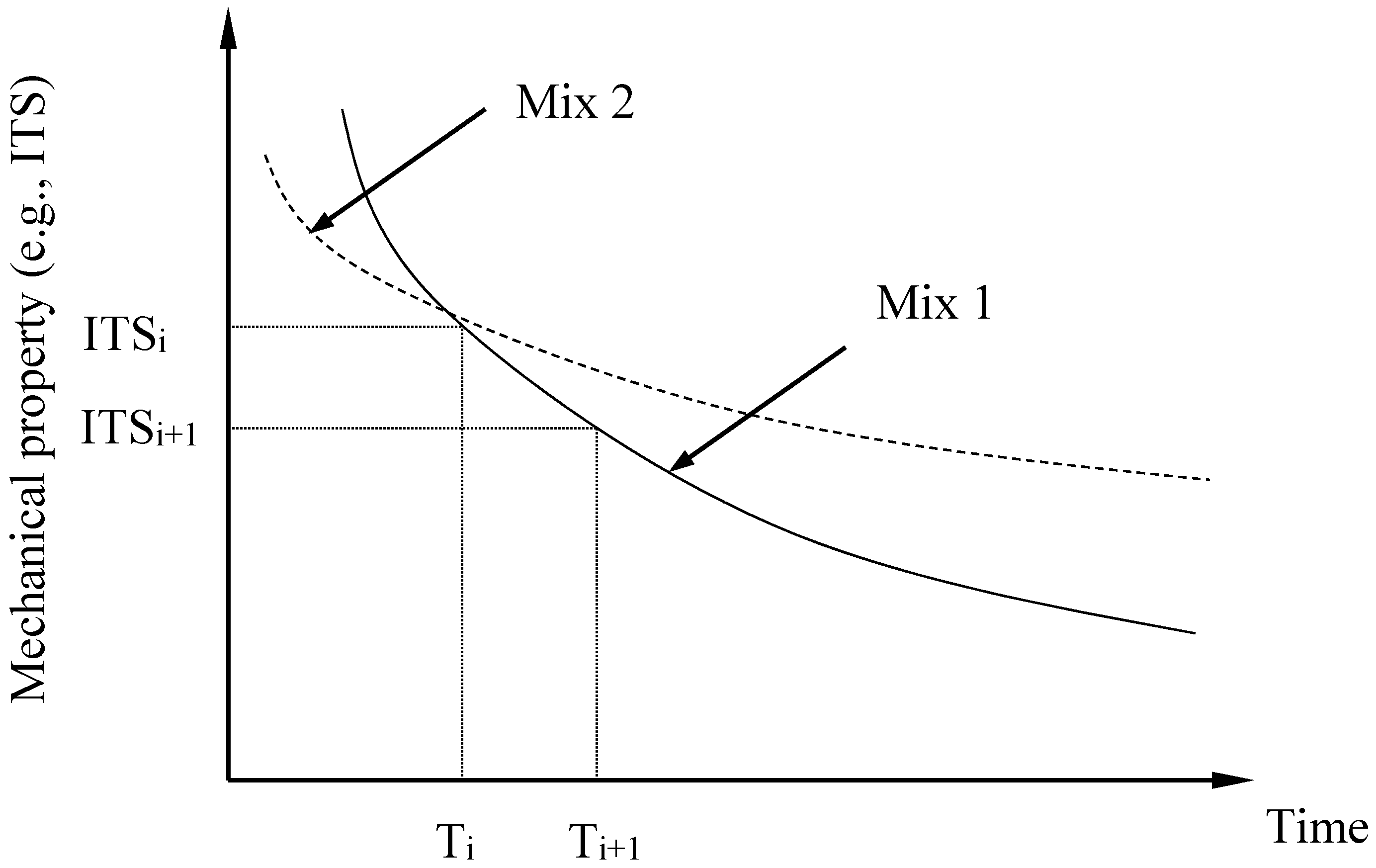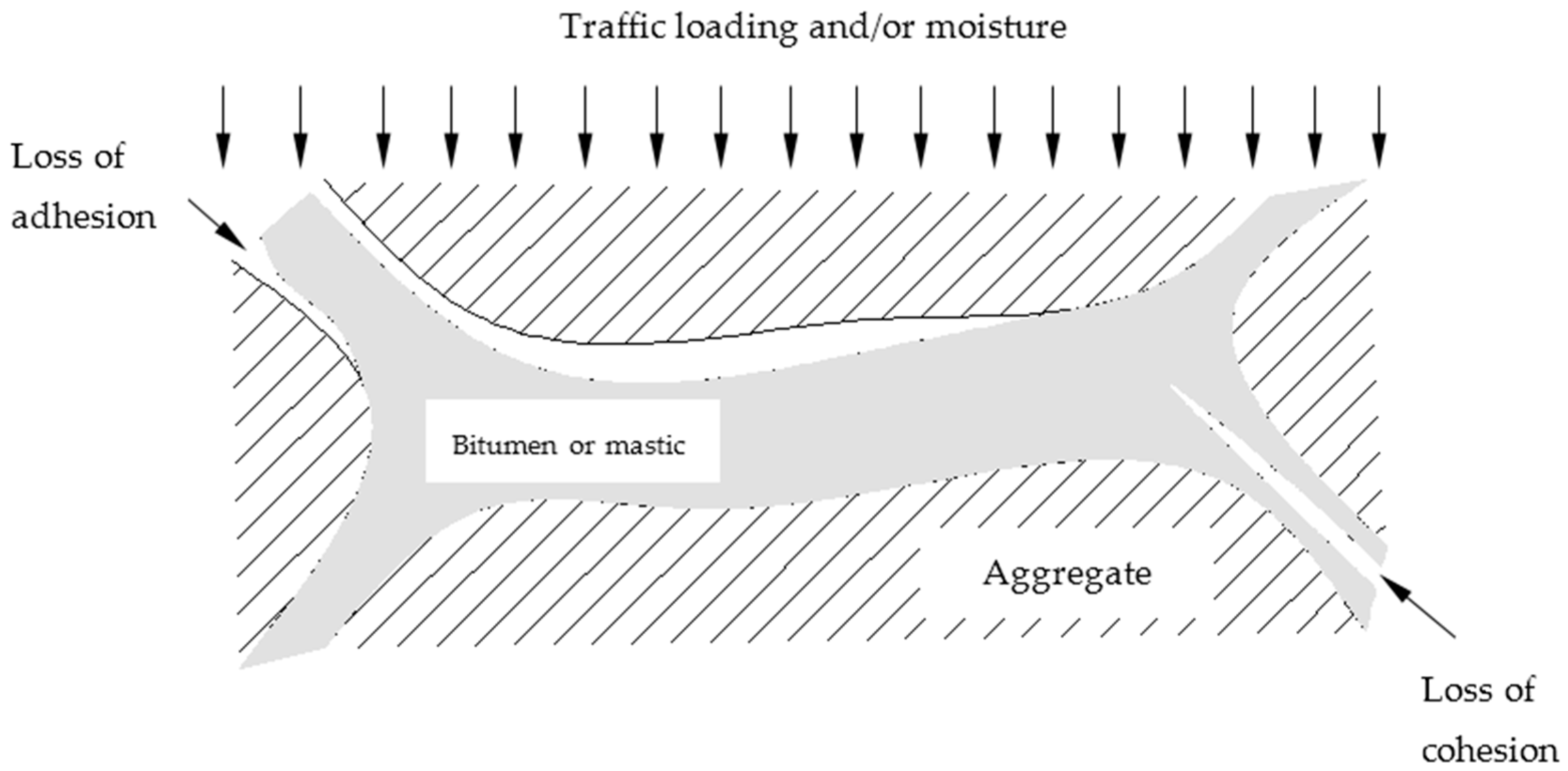Towards an Alternate Evaluation of Moisture-Induced Damage of Bituminous Materials
Abstract
:1. Outlook
2. Challenges
- Does this value guarantee a satisfactory resistance to moisture damage in the long-term? The current practice of the TSR concept is based on short-term aged samples, but the moisture susceptibility is a concern throughout the service life of asphalt pavement.
- What is the proper conditioning method to mimic the moisture damage in real life? Freeze–thaw is used in AASHTO T 283, and the moisture induced stress tester (MIST) was introduced in recent years. Can these methods, or some other method, better mimic real moisture damage?
- As the unconditioned or dry compacted specimens are different from the conditioned or wet specimens, does specimen-to-specimen variability affect the results? Even for the same mixture, the prepared compacted samples would have different distributions of aggregate particles and/or air voids, which affects the measured property. Therefore, the test still lacks repeatability, and its accuracy is questionable.
- Does the saturation level while conditioning affect the repeatability of the results?
- Based on previous studies on the AASHTO T 283 test, a number of successful cases that pass in the laboratory would fail in the field.
3. Opportunities
3.1. First Scenario
3.2. Second Scenario
Author Contributions
Conflicts of Interest
References
- Tarefder, R.A.; Zaman, A. Characterization of Asphalt Materials for Moisture Damage Using Atomic Force Microscopy and Nanoindentation. In Nanotechnology in Civil Infrastructure: A Paradigm Shift; Gopalakrishnan, K., Birgisson, B., Taylor, P., Attoh-Okine, N.O., Eds.; Springer: Berlin/Heidelberg, Germany, 2011; pp. 237–256. [Google Scholar]
- Gubler, R.; Partl, M.N.; Canestrari, F.; Grilli, A. Influence of water and temperature on mechanical properties of selected asphalt pavements. Mater. Struct. 2005, 38, 523–532. [Google Scholar] [CrossRef]
- Alam, M.M.; Vemuri, N.; Tandon, V.; Nazarian, S.; Picornell, M. A Test Method for Identifying Moisture Susceptible Asphalt Concrete Mixes. Research Project 0–1455: Evaluation of Environmental Conditioning System (ECS) for Predicting Moisture Damage Susceptibility of HMAC; The University of Texas at El Paso: El Paso, TX, USA, 1998. [Google Scholar]
- Cho, D.-W.; Kim, K. The mechanisms of moisture damage in asphalt pavement by applying chemistry aspects. KSCE J. Civ. Eng. 2010, 14, 333–341. [Google Scholar] [CrossRef]
- Mohd Hasan, M.R.; You, Z.; Porter, D.; Goh, S.W. Laboratory moisture susceptibility evaluation of WMA under possible field conditions. Constr. Build. Mater. 2015, 101, 57–64. [Google Scholar] [CrossRef]
- Kiggundu, B.M.; Roberts, F.L. Stripping in HMA Mixtures: State-of-the-Art and Critical Review of Test Methods; National Center for Asphalt Technology: Auburn, AL, USA, 1988. [Google Scholar]
- Hamzah, M.; Hasan, M.; van de Ven, M.; Voskuilen, J. Development of Dynamic Asphalt Stripping Machine for Better Prediction of Moisture Damage on Porous Asphalt in the Field. In 7th RILEM International Conference on Cracking in Pavements; Springer: New York, NY, USA; pp. 71–81. [CrossRef]
- Solaimanian, M.; Fedor, D.; Bonaquist, R.; Soltani, A.; Tandon, V. Simple performance test for moisture damage prediction in asphalt concrete. Assoc. Asph. Paving Technol. AAPT 2006, 75, 345–380. [Google Scholar]
- Diab, A.; Sangiorgi, C.; Enieb, M.; You, Z. A conditioning method to evaluate moisture influence on the durability of asphalt mixture materials. Can. J. Civ. Eng. 2016, 43, 943–948. [Google Scholar] [CrossRef]
- Epps, J.; Sebaaly, P.E.; Penaranda, J.; Maher, M.R.; McCann, M.B.; Hand, A.J. Compatibility of a Test for Moisture-Induced Damage with Superpave Volumetric Design; National Academy Press: Washington, DC, USA, 2000. [Google Scholar]


© 2017 by the authors. Licensee MDPI, Basel, Switzerland. This article is an open access article distributed under the terms and conditions of the Creative Commons Attribution (CC BY) license (http://creativecommons.org/licenses/by/4.0/).
Share and Cite
Diab, A.; You, Z.; Yang, X.; Mohd Hasan, M.R. Towards an Alternate Evaluation of Moisture-Induced Damage of Bituminous Materials. Appl. Sci. 2017, 7, 1049. https://doi.org/10.3390/app7101049
Diab A, You Z, Yang X, Mohd Hasan MR. Towards an Alternate Evaluation of Moisture-Induced Damage of Bituminous Materials. Applied Sciences. 2017; 7(10):1049. https://doi.org/10.3390/app7101049
Chicago/Turabian StyleDiab, Aboelkasim, Zhanping You, Xu Yang, and Mohd Rosli Mohd Hasan. 2017. "Towards an Alternate Evaluation of Moisture-Induced Damage of Bituminous Materials" Applied Sciences 7, no. 10: 1049. https://doi.org/10.3390/app7101049
APA StyleDiab, A., You, Z., Yang, X., & Mohd Hasan, M. R. (2017). Towards an Alternate Evaluation of Moisture-Induced Damage of Bituminous Materials. Applied Sciences, 7(10), 1049. https://doi.org/10.3390/app7101049







